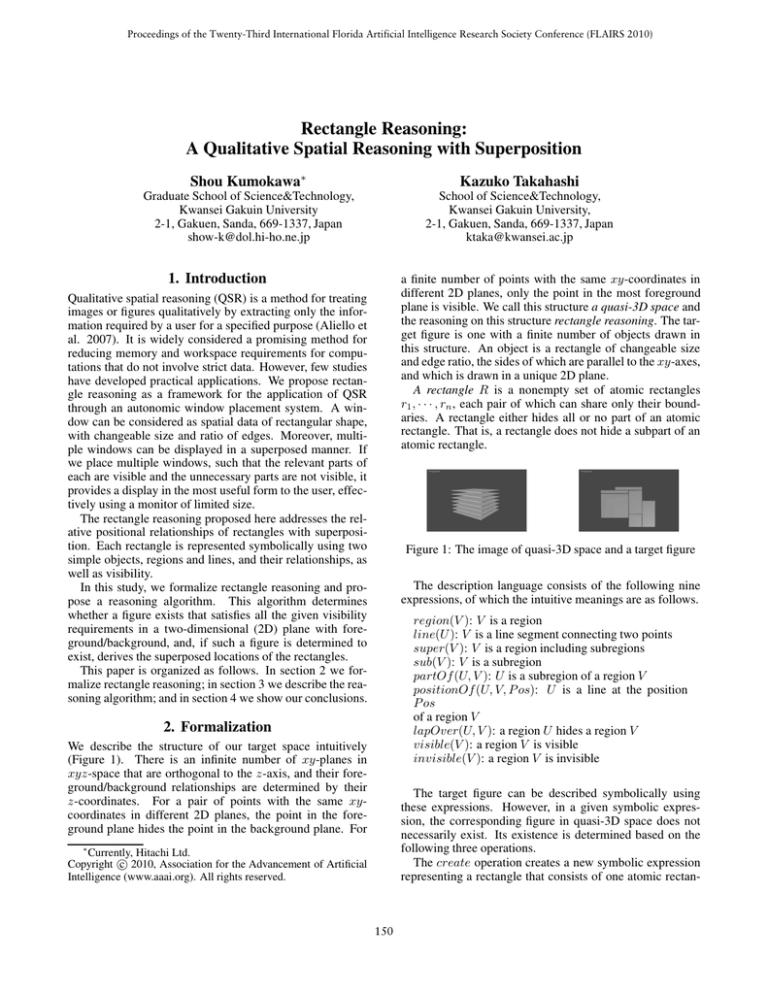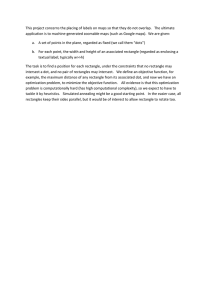
Proceedings of the Twenty-Third International Florida Artificial Intelligence Research Society Conference (FLAIRS 2010)
Rectangle Reasoning:
A Qualitative Spatial Reasoning with Superposition
Shou Kumokawa∗
Kazuko Takahashi
Graduate School of Science&Technology,
Kwansei Gakuin University
2-1, Gakuen, Sanda, 669-1337, Japan
show-k@dol.hi-ho.ne.jp
School of Science&Technology,
Kwansei Gakuin University,
2-1, Gakuen, Sanda, 669-1337, Japan
ktaka@kwansei.ac.jp
a finite number of points with the same xy-coordinates in
different 2D planes, only the point in the most foreground
plane is visible. We call this structure a quasi-3D space and
the reasoning on this structure rectangle reasoning. The target figure is one with a finite number of objects drawn in
this structure. An object is a rectangle of changeable size
and edge ratio, the sides of which are parallel to the xy-axes,
and which is drawn in a unique 2D plane.
A rectangle R is a nonempty set of atomic rectangles
r1 , · · · , rn , each pair of which can share only their boundaries. A rectangle either hides all or no part of an atomic
rectangle. That is, a rectangle does not hide a subpart of an
atomic rectangle.
1. Introduction
Qualitative spatial reasoning (QSR) is a method for treating
images or figures qualitatively by extracting only the information required by a user for a specified purpose (Aliello et
al. 2007). It is widely considered a promising method for
reducing memory and workspace requirements for computations that do not involve strict data. However, few studies
have developed practical applications. We propose rectangle reasoning as a framework for the application of QSR
through an autonomic window placement system. A window can be considered as spatial data of rectangular shape,
with changeable size and ratio of edges. Moreover, multiple windows can be displayed in a superposed manner. If
we place multiple windows, such that the relevant parts of
each are visible and the unnecessary parts are not visible, it
provides a display in the most useful form to the user, effectively using a monitor of limited size.
The rectangle reasoning proposed here addresses the relative positional relationships of rectangles with superposition. Each rectangle is represented symbolically using two
simple objects, regions and lines, and their relationships, as
well as visibility.
In this study, we formalize rectangle reasoning and propose a reasoning algorithm. This algorithm determines
whether a figure exists that satisfies all the given visibility
requirements in a two-dimensional (2D) plane with foreground/background, and, if such a figure is determined to
exist, derives the superposed locations of the rectangles.
This paper is organized as follows. In section 2 we formalize rectangle reasoning; in section 3 we describe the reasoning algorithm; and in section 4 we show our conclusions.
Figure 1: The image of quasi-3D space and a target figure
The description language consists of the following nine
expressions, of which the intuitive meanings are as follows.
region(V ): V is a region
line(U ): V is a line segment connecting two points
super(V ): V is a region including subregions
sub(V ): V is a subregion
partOf (U, V ): U is a subregion of a region V
positionOf (U, V, P os): U is a line at the position
P os
of a region V
lapOver(U, V ): a region U hides a region V
visible(V ): a region V is visible
invisible(V ): a region V is invisible
2. Formalization
We describe the structure of our target space intuitively
(Figure 1). There is an infinite number of xy-planes in
xyz-space that are orthogonal to the z-axis, and their foreground/background relationships are determined by their
z-coordinates. For a pair of points with the same xycoordinates in different 2D planes, the point in the foreground plane hides the point in the background plane. For
The target figure can be described symbolically using
these expressions. However, in a given symbolic expression, the corresponding figure in quasi-3D space does not
necessarily exist. Its existence is determined based on the
following three operations.
The create operation creates a new symbolic expression
representing a rectangle that consists of one atomic rectan-
∗
Currently, Hitachi Ltd.
c 2010, Association for the Advancement of Artificial
Copyright Intelligence (www.aaai.org). All rights reserved.
150
gle. The spliti (i = 1, 2, 3) operation divides an atomic rectangle into two atomic rectangles: one subregion and several
lines depending on i. The putoni operation places a rectangle in the foreground of i previously visible atomic rectangles. Note that rectangles that are already superposed are
not relocated. This operation creates several lapOver, and
the corresponding visible subregions become invisible.
A set of expressions generated from an empty set by
finitely applying the operations create and spliti (i =
1, 2, 3) more than once is called a valid rectangle expression on a plane. A set of expressions generated from a valid
rectangle expression on a plane by finitely applying the operation putoni is called a valid rectangle expression.
the area encircled by a circuit of the connected atomic rectangles corresponds to the position of the rectangle. We
determine the position of the new rectangle by changing
the sizes and ratios of the edges of existing rectangles and
atomic rectangles. Otherwise, the borders of the atomic rectangles are traced in the clockwise direction in the following
manner. We explain this case using an example.
Consider the case in Figure 2, in which the unshaded
atomic rectangles correspond to the subregions with showrequirements, while the shaded ones correspond to the subregions without show-requirements. We show how to judge
whether we can place a single rectangle on a given set of
atomic rectangles so that the former hides the latter.
Starting at the top line of an atomic rectangle (p1) and
reaching the edge of the rectangle in which it is contained
(p2), a search is performed for the top line of the border
of another atomic rectangle. If such a border can be found
(p3), it continues to trace this border until the edge of the
rectangle in which it is contained is reached (p4). In this
case, a supplementary edge is added to connect these points.
Otherwise, it searches for the right line, (if there is no right
line, then it searches for the bottom line, then the left line)
of another atomic rectangle. This procedure is repeated, and
terminates if it returns to the initial point. If the traced path
obtained in this procedure satisfies the following three conditions, then the area encircled by the path corresponds to
the position of the rectangle:
1. All of the borders are contained.
2. Let p1 , . . . , pn be a sequence appearing in a path. Then
p1 , . . . , pt are top edges, pt+1 , . . . , pr are right edges,
pr+1 , . . . , pb are bottom edges and pb+1 , . . . , pn are left
edges.
3. No pair of borders or supplementary edges cross in the 2D
plane.
Then, we determine the position of a new rectangle corresponding to the superregion by changing the sizes and ratios
of the edges of the existing rectangles and atomic rectangles.
We can check conditions 1 and 2 by examining the path,
and condition 3 by checking whether the numbers of vertices, edges, and faces satisfy Euler’s formula when the supplementary edges are added. Figure 3(a) shows an example
in which condition 2 is not satisfied, since the sequence of
the path is {top, lef t, top, lef t}; Figure 3(b) shows an example in which condition 3 is not satisfied, since supplementary edges cross in a 2D plane.
Theorem 2.
.1. (Kumokawa 2009) (i) For a valid rectangle
expression, there exists a target figure in quasi-3D space, (ii)
For a target figure in quasi-3D space, there exists a valid
rectangle expression.
3. Reasoning on Superposition
We can derive a location in quasi-3D space of a valid rectangle expression on a plane that guarantees the visibility of
certain subregions. We add a show-requirement to these subregions as a requirement of visibility.
For a valid rectangle expression, the algorithm searches
for a location in which subregions with show-requirements
are visible and subregions without show-requirements are
invisible. The judgment of whether a superregion can be
placed in a specific position is determined by the precondition of puton; that is, a superregion can hide a set of subregions simultaneously.
p1
p2
p3
p4
a bold line shows a border and a dotted line shows a supplementary edge
Figure 2: Determining the position of a new rectangle
4. Conclusion
(a)
We have demonstrated a rectangle reasoning with superposition. In the future, we will consider the order of arranging
the rectangles for efficient placement.
(b)
References
Figure 3: Examples in which conditions are not satisfied
Aliello,M., Pratt-Hartmann,I.E., and Vanbenthem,J.F.A.K. 2007.
Handbook of Spatial Logics, Springer-Verlag.
Kumokawa,S. 2009. Qualitative Spatial Reasoning System Based
on Rectangles with Visibility and Its Application. Master’s Thesis, School of Science & Technology, Kwansei Gakuin University,
Japan (In Japanese).
Suppose that such a placement is achievable. Here, a border is an edge of an atomic rectangle that is not an edge of
the rectangle in which it is contained. If all of the atomic
rectangles are connected with no space between them, then
151





